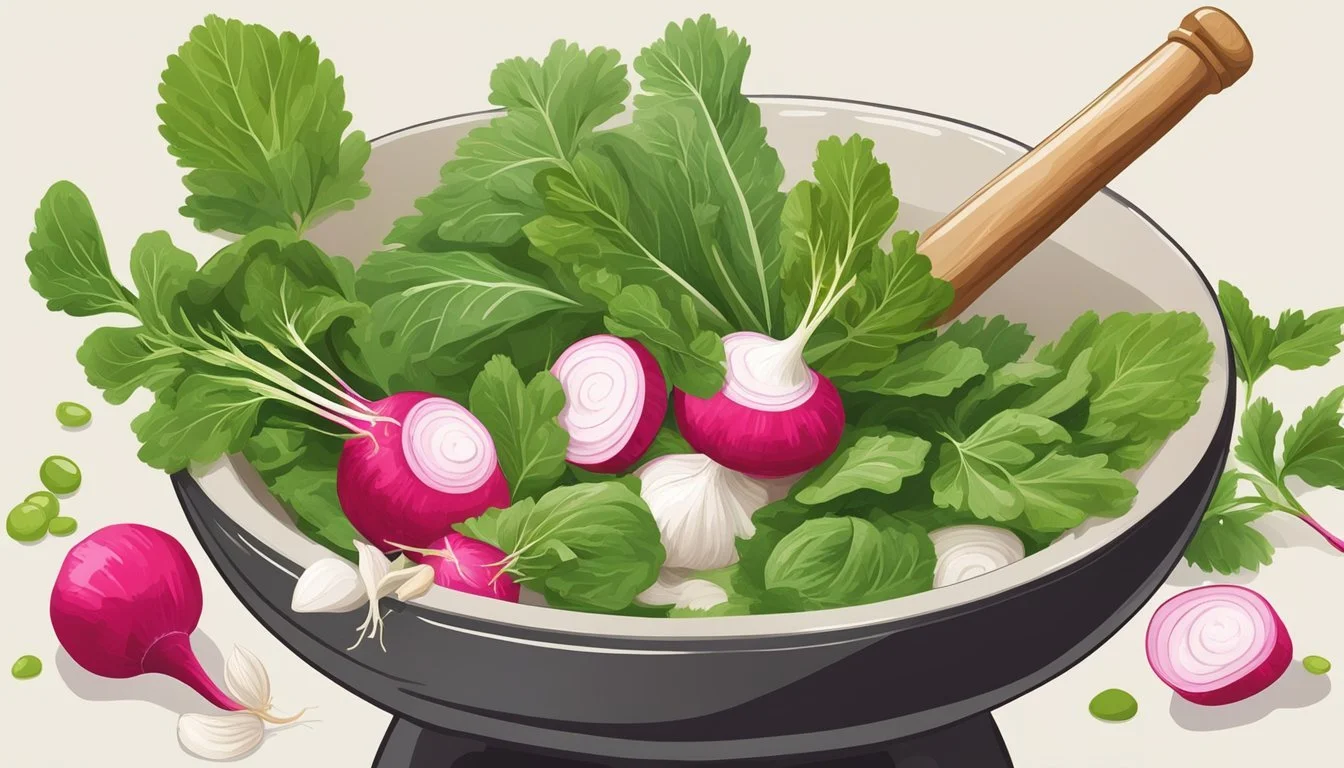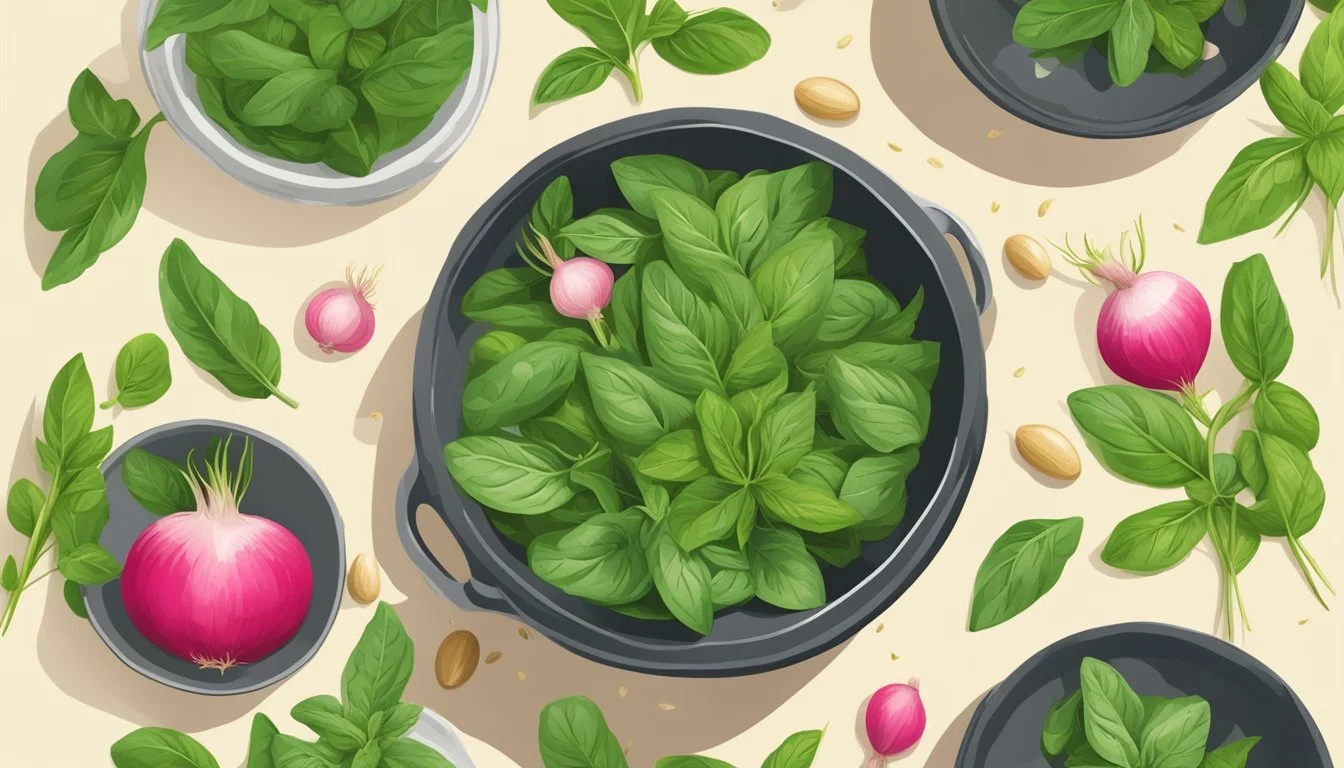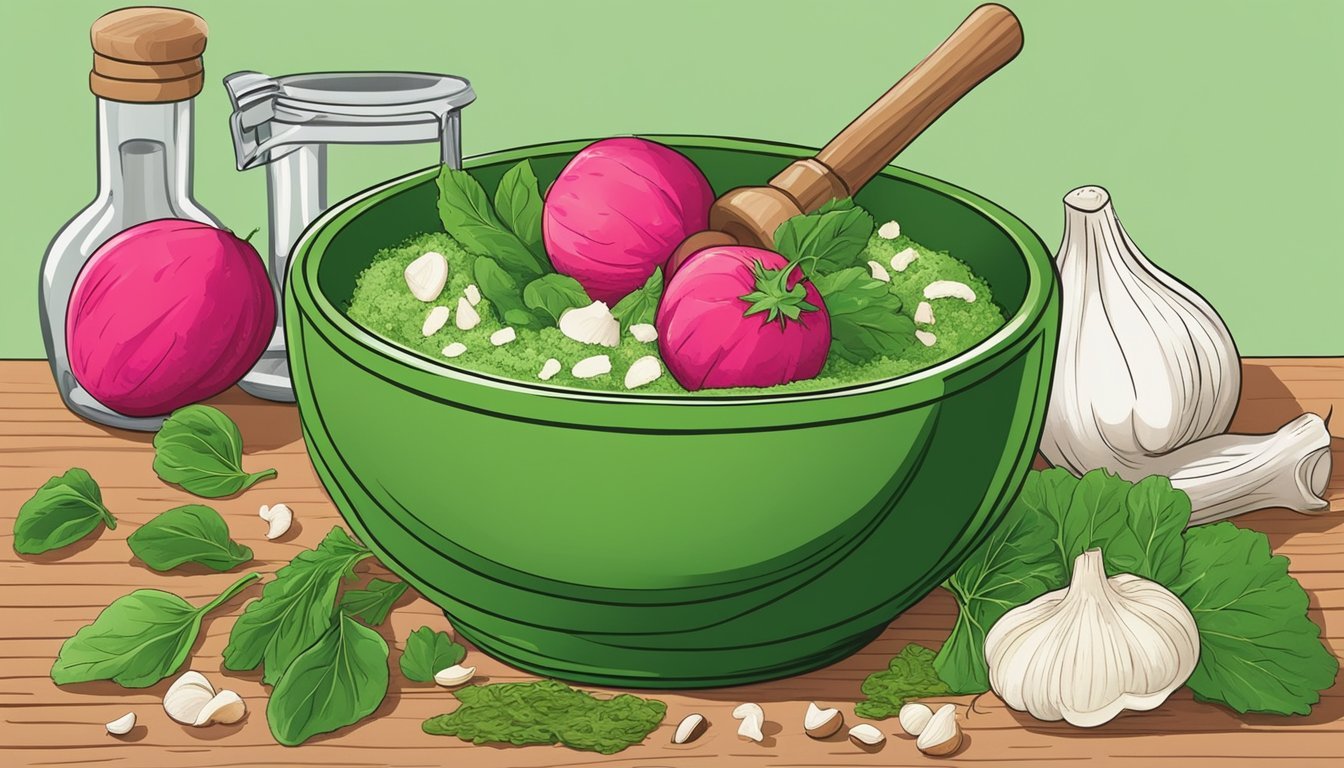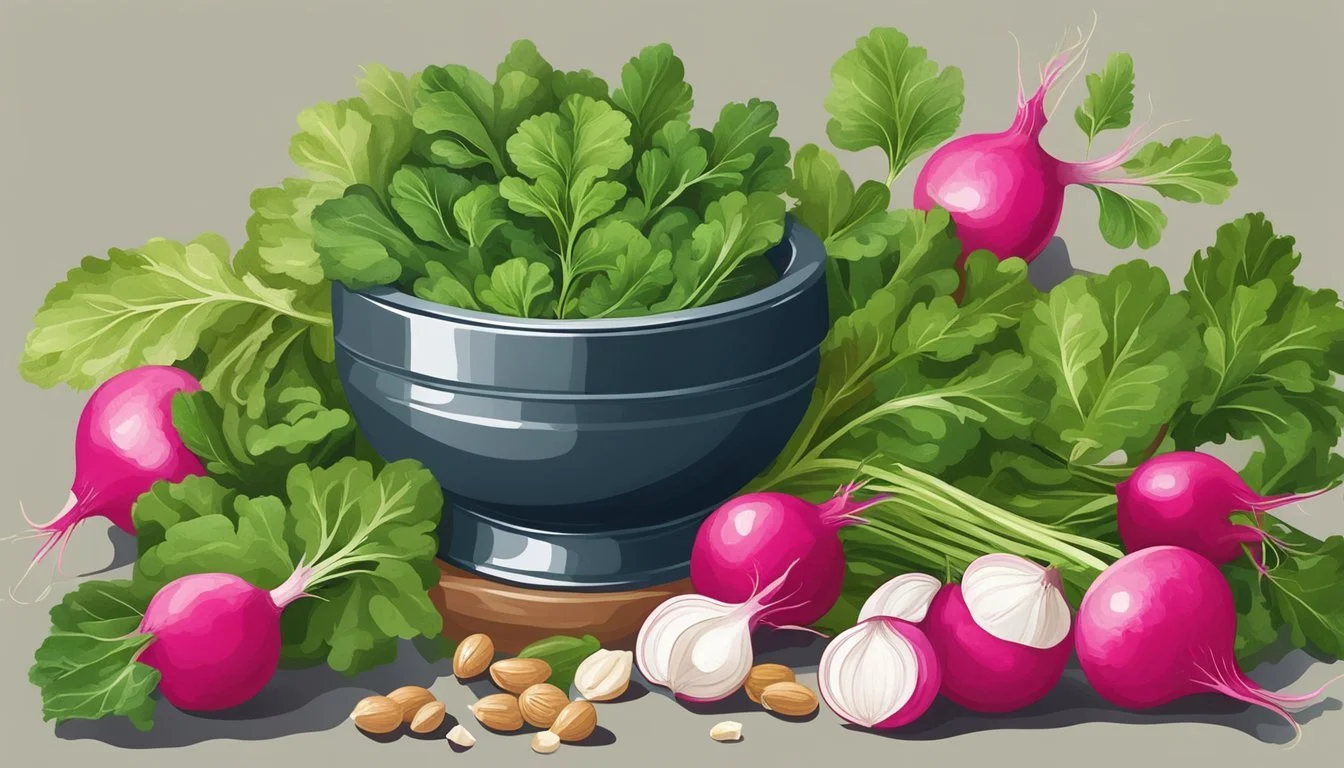Radish Leaf Pesto
Elevating Traditional Flavors with a Spicy Kick
Radish leaf pesto offers a creative and flavorful way to use the often discarded tops of radishes. This variation of pesto retains the iconic sauce's essence, bringing a peppery punch and a hint of earthiness that complements the classic blend of nuts, cheese, and oil. It’s not just a sustainable choice, cutting down on food waste, but also a gastronomic revelation, introducing a fresh spin to the familiar basil-based condiment.
Although traditional pesto is typically made with basil, the use of radish leaves in pesto is becoming popular among those seeking to explore new tastes and textures. These peppery greens are blended with ingredients such as parmesan, nuts—pine or otherwise—and a good quality olive oil to create a sauce that is both rustic and refined. Lemon juice is often added to balance the peppery flavor of the radish leaves with a bright citrus note, making it a versatile addition to numerous dishes.
The process of making radish leaf pesto is similar to creating traditional pesto and can be done easily with a food processor or blender. Cleaned radish tops are finely chopped along with garlic, nuts, and grated cheese, then emulsified with olive oil until the mixture reaches the desired consistency. Seasoned with salt, and sometimes pepper, this sauce can be adjusted according to taste, making each batch unique to the creator’s palate.
Exploring the Key Ingredients
In the creation of Radish Leaf Pesto, the selection of each ingredient plays a crucial role in forming the unique taste and nutritional profile of the sauce. Understanding the components will help one appreciate the layers of flavor in this peppery twist on a classic pesto.
The Radish Leaf Advantage
Radish leaves, often discarded as waste, are the star of this pesto. They are packed with vitamin C, iron, and potassium, conferring not just vibrant peppery flavors but also notable nutritional benefits. Radish greens contribute a slightly spicy edge, distinguishing this pesto from its traditional basil counterpart.
Picking the Perfect Nuts
Nuts provide a crunchy texture and depth to pesto. Common choices include:
Pine nuts: traditional but pricey
Walnuts: robust flavor and affordability
Almonds: a mild, sweet twist For nut-free alternatives, sunflower seeds or pumpkin seeds (pepitas) can be used, offering a similar texture and healthful fats.
Selecting Your Oil
The oil in pesto acts as a binder and flavor enhancer. Extra virgin olive oil is the preferred choice for its superior taste and health properties. It should be added slowly while blending to achieve the desired creamy consistency.
Garlic and Cheese Duos
Garlic adds a pungent kick, pivotal to pesto’s flavor. One or two cloves usually suffices to prevent overpowering the sauce. Parmesan cheese imparts a salty, umami character that complements the radish leaves. Freshly grated ensures optimal flavor.
Enhancing Flavors
Balancing the flavors is key:
Salt: fine sea salt to amplify taste
Pepper: freshly ground black pepper for warmth and spice
Lemon juice: brightens the overall flavor, adding a touch of acidity.
Extra Additions for Taste
Herbs like parsley, mint, or basil can be incorporated to add complexity and freshness, while not detracting from the radish greens. These should be chosen based on personal preference and desired flavor outcome.
Complementary Pairings
Radish leaf pesto, with its peppery twist, offers a unique and pungent alternative to traditional basil pesto. Its bold flavors can enhance a variety of dishes while contributing to the nutritional and health benefits of meals.
Pasta and Pesto: A Classic Combination
When mixed with pasta, radish leaf pesto imparts a refreshing, zesty flavor that pairs seamlessly with the subtle taste of classic noodles. Whole grain pastas provide a hearty texture that nicely contrasts the pesto’s peppery bite. For a health-conscious choice, one might opt for gluten-free spaghetti or zoodles (zucchini noodles) for a satisfying, low-carb meal.
Vegetable Medleys
Radish leaf pesto can elevate simple vegetable dishes, turning them into culinary delights. It acts as a harmonious addition to roasted radishes, peas, broccoli, carrots, celery, and kale. Whether served as a side salad or blended into a nourishing soup, the pesto introduces a piquant flavor profile that complements the natural taste of fresh vegetables.
Pesto as a Protein Accent
This verdant sauce is not only for vegetarians and vegans; it can also be a delectable accent to proteins. Drizzled over grilled chicken or fish, the pesto adds a layer of complexity and zest. When paired with a tuna burger or folded into a quinoa salad, it boosts both the flavor and the nutritional content, contributing healthy fats and vitamins.
Creative Pesto Applications
Beyond traditional uses, radish leaf pesto is versatile as a spread or dip. It can revitalize a sandwich, add depth to pizza toppings, or enhance the taste of warm, freshly baked bread. The pesto's assertive flavor ensures it stands out, whether used in a dollop on top of a soup or as a stand-alone dip for crudités.
Recipe Execution
When making radish leaf pesto, the chef adheres to a meticulous process to ensure the flavor and texture meet the highest standards. The preparation requires a food processor or blender, and proper seasoning is key for achieving the desired peppery yet milder flavor.
Step-by-Step Pesto Preparation
First, one should wash the radish leaves thoroughly, preferably using a salad spinner to remove excess moisture. Ingredients are best combined in stages:
Pulse garlic, nuts (like walnuts or pine nuts), and coarse salt in the food processor until coarsely ground.
Add the radish greens along with any other chosen herbs, like basil or mint, to the mixture and process.
Incorporate liquids, typically lemon juice and extra virgin olive oil, and blend until the pesto reaches the desired consistency.
Prep Time: Approximately 10-15 minutes
Total Time: 15-20 minutes
Servings: Typically yields about 1 cup of pesto
Consistency and Texture
Achieving the perfect consistency requires starting with drier leaves to prevent a watery pesto. They add the oil gradually, stopping the food processor periodically to scrape down the sides. For a smoother texture, they blend for a longer duration, while a shorter blend results in a chunkier pesto.
Herbs and Seasoning Balance
The radish leaves impart a distinctive peppery flavor, so they adjust the seasoning cautiously to ensure a harmonious balance with other ingredients. A squeeze of lemon juice can enhance the freshness, while a touch of salt underscores the natural flavors. The final taste should be robust but not overpowering, allowing the radish leaf's unique character to shine through.
Storing Your Pesto
Proper storage techniques are critical to extending the edible life of radish leaf pesto, thus minimising food waste. Below are specific strategies for refrigeration and freezing to preserve the freshness and flavor of the pesto.
Short-Term Refrigeration
For short-term storage, radish leaf pesto should be stored in the refrigerator. Do the following:
Transfer the pesto into an airtight container to protect it from air exposure.
Press a piece of plastic wrap directly onto the surface of the pesto to minimize air contact, then cover with the lid.
The pesto can be expected to maintain its quality for up to 1 week when stored in the fridge.
Long-Term Freezing Tips
When freezing radish leaf pesto, follow these steps:
Portion the pesto into ice cube trays or small containers for easy usage.
Freeze until solid, and then transfer into larger airtight containers or freezer bags.
Label with the date to keep track of the shelf life. Pesto can be stored in the freezer for 3 to 6 months.
By freezing it this way, it allows individuals to use small amounts as needed, reducing the risk of defrosting and refreezing, which can lead to degradation of taste and texture.
Maximizing Freshness
There are additional practices that can further ensure the pesto retains its best quality over time:
Make sure to always use clean utensils when scooping pesto out of its storage container. This reduces the risk of introducing bacteria that can spoil the food.
If oil separates from the pesto after thawing, simply stir it to restore its consistency.
By following these guidelines, the radish leaf pesto can be enjoyed at its best quality for longer periods, thus cutting down on food waste without sacrificing flavor.
Nutritional Profile and Benefits
Radish leaf pesto, often created from the overlooked tops of radishes, not only offers a unique peppery twist to dishes but also possesses a rich nutritional profile. Loaded with vitamins and minerals, these greens contribute beneficial nutrients for very few calories.
Macro and Micronutrient Breakdown
Calories: Radish greens are low in calories, making them an excellent addition to a health-conscious diet.
Carbohydrates: They contain a minimal amount of carbohydrates, most of which are dietary fiber, aiding digestion.
Fat: Radish leaves are virtually fat-free but, when made into pesto, gain healthy fats from added ingredients like olive oil and nuts.
Protein: There is a modest amount of protein in radish greens.
Fiber: These leaves are a good source of dietary fiber, essential for gastrointestinal health.
Vitamins and Minerals:
Vitamin C: A powerful antioxidant, crucial for immune function and skin health.
Iron: Important for blood health and energy levels.
Calcium: Essential for bone strength and structure.
Potassium: Helps regulate fluid balance and blood pressure.
Nutritional Values Table
Nutrient Amount per 100g Calories Low Carbohydrates Low Fat Low Saturated Fat Low Cholesterol None Sodium Low Fiber High Vitamin C High Iron Moderate Calcium Moderate Potassium Moderate
Healthful Attributes
Radish greens are recognized for their health benefits due to their nutritional composition. They’re particularly known for being:
Heart-friendly: The fiber and potassium in radish leaves support cardiovascular health.
Bone supporting: The presence of calcium is beneficial for maintaining strong bones.
Immunity-boosting: High levels of Vitamin C in these greens help protect the immune system.
Consuming radish leaf pesto incorporates these healthy attributes into one's diet, along with the nutritional benefits of the additional ingredients like nuts and olive oil that are rich in healthful fats.
Reducing Food Waste
In the culinary world, reducing food waste is not just environmentally responsible, it also allows for creativity in using ingredients like radish greens, often discarded, in innovative dishes.
Using Kitchen Scraps Effectively
Radish greens, typically ignored and tossed aside, are a prime example of a valuable kitchen scrap that is both edible and nutritious. They carry a distinct peppery flavor that can enhance a variety of dishes. Here are some specific ways to use these greens effectively:
Salad Additions: Radish leaves can be refreshed in cold water, chopped, and mixed into salads for a peppery kick.
Vegetable Broths: Scraps can be saved in the freezer until enough accumulate to make a rich, homemade vegetable broth.
Smoothies: For a nutrient boost, one can blend radish tops into green smoothies.
Composting: If not used in cooking, radish leaves can be composted, contributing to a cycle of sustainability rather than waste.
Radish Tops Beyond Pesto
While radish leaf pesto is a creative way to reduce food waste, these greens have other versatile uses:
Vegetable Soup: Radish tops can be chopped and added to vegetable soups for added nutrition and a peppery taste.
Garnish: When finely chopped, they serve as a garnish with a visual appeal and a flavor boost.
By incorporating radish tops into regular cooking routines, not only does one reduce food waste significantly, but one also broadens the culinary use of what is often seen as mere scraps into an exploration of the rich potential of all parts of produce bought from the market.





